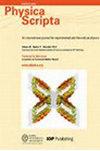Neural network approach to investigate heat transfer in SWCNTs nanofluid within trapezoidal cavity with varied corrugated rod amplitudes
IF 2.6
3区 物理与天体物理
Q2 PHYSICS, MULTIDISCIPLINARY
引用次数: 0
Abstract
This article presents Artificial Neural Networks (ANN) for convective heat transfer in a trapezoidal cavity subjected to corrugated heated rod inside it. The LevenbergMarquardt algorithm is utilized to optimize the Neural Networks. The trapezoidal cavity has low-temperature inclined walls and adiabatic upper and lower walls compared to the corrugated heated rod. Single-wall carbon (SWCNTs) nanomaterials are submerged in the base liquid water. The flow of SWCNTs-water is generated due to the temperature gradient in the cavity. The system of dimensional partial differential equations has been formulated for the physical setup under investigation. The dimensional system has been converted into a non-dimensional form using dimensionless variables. Finite element is used for the solutions. The dimensionless functions velocity, temperature, and heat transfer rates are studied against the Rayleigh number (Ra). The outcomes are presented in the form of isotherms, contours, tabular values, and graphs. The data for Artificial Neural Networks (ANN) has been generated by FEM against the Nusselt number. The ANN has been trained for a specific amplitude of the rod and predicted heat transfer against a larger amplitude. The results show good agreement for both training and testing data. The outcomes of analysis reveals that convection caused by temperature gradient is dominant for higher values of the Rayleigh number (Ra). Local Nusselt number has been discussed against different amplitudes, and predicted enhancement for the larger amplitude of the rod.用神经网络方法研究梯形腔内不同波纹杆振幅的 SWCNTs 纳米流体的传热问题
本文介绍了人工神经网络(ANN)用于梯形空腔内波纹加热棒的对流传热。采用 LevenbergMarquardt 算法对神经网络进行优化。与波纹加热棒相比,梯形空腔具有低温倾斜壁和绝热上下壁。单壁碳纳米材料(SWCNTs)被浸没在基础液态水中。由于空腔中的温度梯度,SWCNTs-水产生流动。针对所研究的物理装置,我们制定了维度偏微分方程系统。使用无量纲变量将量纲系统转换为非量纲形式。有限元用于求解。针对雷利数 (Ra) 对无量纲函数速度、温度和传热率进行了研究。研究结果以等温线、等值线、表格值和图表的形式呈现。人工神经网络(ANN)的数据是由 FEM 根据努塞尔特数生成的。已针对杆的特定振幅对人工神经网络进行了训练,并针对更大的振幅对传热进行了预测。结果显示,训练数据和测试数据的一致性都很好。分析结果表明,温度梯度引起的对流在雷利数(Ra)值较高时占主导地位。针对不同振幅对局部努塞尔特数进行了讨论,并预测了较大振幅杆的增强效果。
本文章由计算机程序翻译,如有差异,请以英文原文为准。
求助全文
约1分钟内获得全文
求助全文
来源期刊

Physica Scripta
物理-物理:综合
CiteScore
3.70
自引率
3.40%
发文量
782
审稿时长
4.5 months
期刊介绍:
Physica Scripta is an international journal for original research in any branch of experimental and theoretical physics. Articles will be considered in any of the following topics, and interdisciplinary topics involving physics are also welcomed:
-Atomic, molecular and optical physics-
Plasma physics-
Condensed matter physics-
Mathematical physics-
Astrophysics-
High energy physics-
Nuclear physics-
Nonlinear physics.
The journal aims to increase the visibility and accessibility of research to the wider physical sciences community. Articles on topics of broad interest are encouraged and submissions in more specialist fields should endeavour to include reference to the wider context of their research in the introduction.
 求助内容:
求助内容: 应助结果提醒方式:
应助结果提醒方式:


